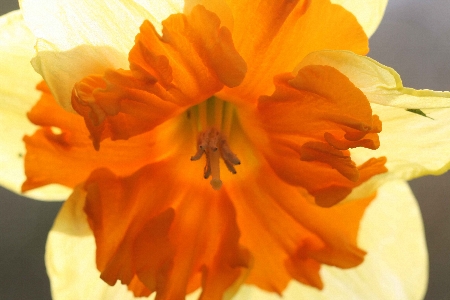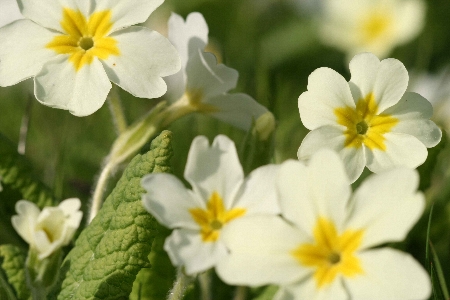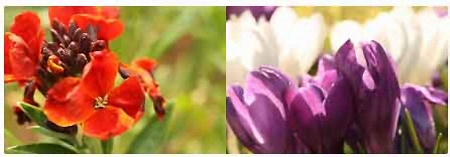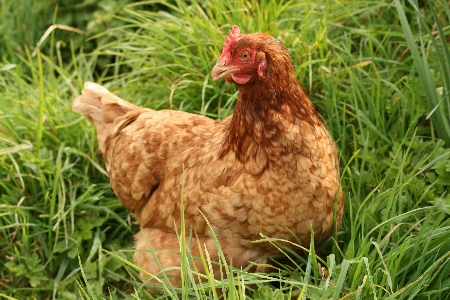
Spring has arrived all at once in a terrible rush. A grey sleeping desolate garden has woken up with a jolt as if it had overslept; nothing, then everything. Snowdrops, weeks late poured daintily down the hillside trickling coldly, whitely into the garden, early daffodils refused to open their faces to the icy northeast wind, grass wouldn’t grow. For weeks and weeks we fed sheep and lambs up to the top fields morning and evening. Donkeys lost weight despite extra tea, no bad thing, though, for fat Mr Luke. Chickens reduced their run to a mud slide and had to come into the big barn on straw to dry off before being allowed to scratch in the orchard.

Then suddenly we saw the sun, the orchard flooded with daffodils, the whole garden exploding in a yellow cascade as far as the eye could see, one variety after another till we lost count.

Primroses still carpet the slope behind the house in a mixture of yellow and pink and now suddenly all is speckled with white plum blossom which we pray will be spared by late frost.
And so now the race is on. We are in the National Garden Scheme “Yellow Book” scheduled to open for charity in just seven weeks and we’ve foolishly booked a weeks’ holiday right now. So day after day, in this wonderful early April sun, I dig and plant, plant and weed, all the time staring at the soil to see what has survived and what has perished in the unnaturally cold winter. Miraculously mecanopsis are pushing up furry pale green shoots through hard cold ground. The Ceanothus looks very sick. We held our breath as we looked at the twiggy embothrium which maybe is greening up and slowly recovering its strength. Not so good, Garrya elliptica, who had to have a severe pruning to remove all branches of dead catkins dripping majestically over the pond reducing it to an awful skeletal shadow of its former self but will, I hope, shoot again. Not so my beloved blue ceratostigma. Every day I check for a sign of life on brown twigs but I fear the severe cold has done for them, alas.


But spring growth begins again and new seeds are germinating. Some, already in need of pricking out, must be tended before my weeks’ leave. Vegetable garden squares are dug ready to receive beans, peas, brassicas, courgette, all sitting patiently in trays in the poly tunnel. Sweet peas begin the long climb up their poles. Scarlet stemmed chard, shallots, beetroot and parsley lie waiting to burst into life in the warming soil.
As we dug our way through the vegetable garden last week, I gathered a strange little crop of edible survivors; a few skinny leeks, some early maverick potatoes missed last year, eye watering roots of horse radish, twigs of rosemary and a bucketful of Jerusalem artichokes.
Last night I cooked a small Guinea fowl. We had the leeks in a light cheese sauce and the potatoes and artichokes, sliced and blanched briefly, then “stoved” till slightly crisp, in butter and olive oil; delicious.
Now is the time to finish up all last years produce, empty the deep freeze and look in the back of the larder for forgotten jams and chutneys, tomatoes in olive oil and figs in vanilla syrup!
I find that frozen beans of all varieties cheer up no end with the addition of a tin of tomatoes, a few dried herbs and a clove of garlic crushed in salt. The mange tout seem to reawaken cooked gently in butter, no water at all, but under a firm gaze so they don’t brown and turn bitter. A glut of courgettes, curried and frozen, made another transition into a delicious Mulligatawny style soup with the help of stock from the carcass of a big Easter chicken.
We’re still adding iridescent sparkling red quince jelly to yoghurt or vanilla ice cream, spreading quince marmalade on toast and eating membrilo with ripe Cornish brie. Last week I took quince from the freezer which I had frozen, without ceremony, last autumn, we had so many on our one pretty tree. They looked very unattractive as they brownly defrosted but with the addition of whipped cream, a meringue mix of egg white and sugar and a little gelatine soaked in raspberry juice they made a surprisingly respectable and delicate mousse.
Last years lamb must be eaten too. I plan a slow cooked Navarin of boned shoulder with the first new potatoes, carrots, turnips, garlic and peas and a couple of tomatoes. We’ll have roast leg of lamb with rosemary and more Jerusalem artichokes too.
Best of all, I will cook the delightfully named “Best end of neck in the style of the Bakers Wife” from Jane Grigson’s wonderful “Vegetable Book” Penguin 1978.
Traditionally this French country dish followed the bread baking into the oven at the village bakers. Each housewife would prepare her raw ingredients at home then carry the pot down the road to be cooked in the big communal bread oven as it cooled, stipulating if possible, where her dish should be placed.
First the trimmed and chined neck is browned in butter. Then it is layered with sliced onions and thinly sliced and blanched potatoes, some seasoning and a few herbs. It is baked long and slow, in a moderate oven till all flavours amalgamate and the meat falls from the bone, potatoes browned on top. It is not a million miles from our own Lancashire hotpot.
So off to France now for a week of wonderful food, the company of old friends and, of course a dash to Carrefour before the ferry returns us to Plymouth, (volcano chaos allowing) and garden toil once more.

I am NOT a Guinea Fowl!
Leave a Reply